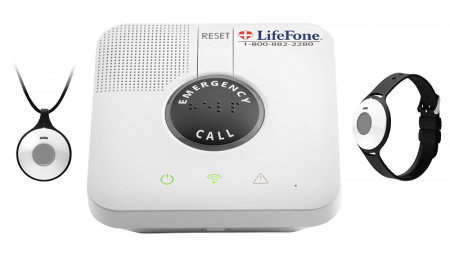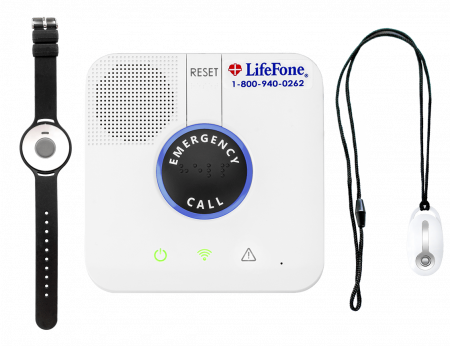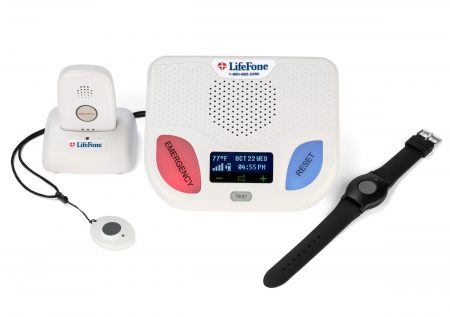Best for Dual-User System

LifeFone has been in the emergency monitoring industry since 1976. The company and all of its employees are U.S.-based, and it provides services to thousands of people throughout the nation. All LifeFone equipment is UL-certified. The company maintains an A+ rating with the Better Business Bureau.
LifeFone offers four medical alert systems, three of which have an option for free spousal monitoring. This policy allows a second person in the same home to join the original subscriber’s plan at no additional cost, providing two people with coverage for the price of one. Unlike other companies, LifeFone does not even charge a fee for a second standard personal help button. Spousal monitoring with LifeFone can save couples several hundred dollars per year compared to paying for two devices and service plans separately.
Who LifeFone Is Best For
Couples
LifeFone’s free spousal monitoring policy can be a huge money saver for couples. Its systems include a standard personal help button that may be used by a second person free of charge (though there is a small fee of several dollars per month for a fall detection pendant.) Still, compared to paying for two individual service plans, the LifeFone free spousal monitoring can save couples $300 or more per year.
Smartphone Users
LifeFone users also have the option of using the Mobile Alert mobile app. When the app is open, a “panic button” appears on the screen that users may touch to call the emergency monitoring center. There are two additional buttons for other situations. First, a concern button that users can press when in need of a virtual escort in situations that make them nervous. Second, a medical button to signal that they need immediate medical attention. The app costs $5.95 a month for existing LifeFone users and is available for both Apple and Android devices.
Stylish Seniors
In addition to its standard, waterproof medical alert pendants, LifeFone also offers stylish Vanity Pendants. Vanity pendants look just like a regular necklace, so seniors can be protected by LifeFone without interfering with their outfits. Vanity pendants are only compatible with LifeFone’s in-home systems and must be purchased for a one-time fee of $71.95. After the initial purchase, there is no extra cost to use a vanity pendant.
Plans and Starting Costs
LifeFone systems range in price from $29.95 a month to $46.95 a month when paid for on a month-to-month basis. All LifeFone systems may also be paid for on a quarterly or annual basis; these plans save customers several dollars per month.
LifeFone customers may cancel their service at any time without paying a penalty. Those who have prepaid months at the time of cancellation receive a prorated refund. Additionally, if customers are unsatisfied with their system, they may return it within the first 30 days for a full refund. The 30 day refund policy applies to all LifeFone systems and all payment plans.
Starting Costs
There are no device, activation, or installation fees for any LifeFone devices. Free shipping is included with quarterly and annual payment plans. Those who choose month-to-month payment must pay $14.95 for shipping.
Device Prices and Features

At-Home Landline
Device Features
The At-Home Landline system includes a base station with a range of 1,300 feet and a 32-hour backup battery to keep the system running in the event of a power outage, and a personal help button that connects users to the emergency monitoring center. The personal help button may be worn as a pendant or wristband and is completely waterproof so users can wear it in the shower. Fall detection is available for an additional $5 a month. Users must have a working landline connection in their home; there is no cellular option for the standard At-Home.
Pricing
The At-Home device is LifeFone’s least expensive system, costing $29.95 a month with a monthly payment plan. The quarterly and annual plans are both slightly less expensive. The quarterly plan costs $27.95 a month, and the annual plan saves users the most money per month, at $22.87 a month.
At-Home Cellular

Device Features
This system uses AT&T’s cellular network rather than a landline, so it is an option for those who want in-home protection but do not have a working landline. Otherwise, the system has all of the same features and components as the standard At-Home. Users who want automatic fall detection may add the feature to their service plan for an additional $5 a month.
Pricing
At-Home Cellular costs $34.95 a month including cellular service with AT&T’s network. The quarterly plan and annual plan save users several dollars per month, at $32.95 and $28.14, respectively.
At-Home & On-the-Go GPS

Device Features
This system provides in-home protection with on-the-go coverage. It includes two different systems: an At-Home Cellular, and a portable device. Both devices use AT&T’s cellular network and are waterproof and shower-safe. The portable device is not all-in-one, so users wear their personal help button at all times, plus a small mobile device while outside of the home. The mobile device is approximately the size of a deck of cards and easily fits in a pocket, purse, or belt clip. The portable device’s battery lasts 24 hours between charges.
Pricing
The At Home & On-the-Go GPS system costs $39.95 a month with a monthly or quarterly plan, or $33.87 a month with an annual plan. Fall detection is available for this system and costs an additional $10 a month.
At-Home & On-the-Go GPS, Voice-in-Necklace

Device Features
This is LifeFone’s only entirely portable system. It is an all-in-one, lightweight mobile device with a built-in personal help button and two-way speaker. The device is worn as a pendant, and is the only piece of equipment that users need to have on them in order to be protected; there is no additional portable base station. Users may choose between Verizon or AT&T cellular service, and GPS service is included. The device’s battery life can last up to 30 days, or 5 days when used with automatic fall detection. Fall detection costs an additional $5 a month.
Pricing
At-Home & On-the-Go GPS, Voice in Necklace costs $43.95 a month when paid for on a monthly basis. The quarterly plan costs $41.95 a month, and the annual plan costs $36.62 a month.
| At-Home | At-Home Cellular | At-Home & On-the-Go GPS | At Home & On-the-Go GPS, Voice-in-Necklace | |
| Monthly Cost | $29.95 | $34.95 | $39.95 | $43.95 |
| One-time fees | N/A | N/A | N/A | N/A |
| Type of Device | In-home system | In-home system | In-home and mobile system | Mobile system |
| Connection | Landline | Cellular | Cellular | Cellular |
| Battery Life | 32-hour backup | 32-hour backup | 24 hours; 30-hour backup | 30 days |
| Water Resistant | Yes | Yes | Yes | Yes |
| Shower-proof | Yes | Yes | Yes | Yes |
| Range | 1,300 feet | 1,300 feet | 1,400 feet in-home, 600 feet mobile | N/A |
| Fall Detection | $5 a month | $5 a month | $10 a month | $5 a month |
Optional Features and Devices
Activity Assurance
The Activity Assurance feature makes it easy for LifeFone users to quickly signal that they are going about their day as normal. If a user chooses this feature as part of their plan, every day at a scheduled time, their base station will beep. Users can press a button to stop the alert and signal to the monitoring center that everything is okay. Activity Assurance can provide peace of mind for caregivers who may worry about their loved one falling ill or having an emergency. This feature costs $6 a month and is only available with in-home systems.
Daily Check-In Call
Another option for caregivers who want peace of mind that their loved one is safe is a daily check-in call. Users select the time of day they would like to receive the call, and the type of call (basic check-in, medication reminder, etc). The call confirms that the user is safe and healthy. If the user does not answer and has not told the monitoring center that they will be out of the house, an operator will alert the user’s emergency contacts. If there are no contacts on file, emergency services will be dispatched. This service costs $19 a month and is available with all LifeFone systems.
Medication Reminders
Medication reminders alert a user when it is time to take their daily medication. It is particularly useful for forgetful seniors or those who have a complicated medication regimen. Caregivers can program up to 4 medication reminders per day. At the pre-set times, an alarm will sound through the user’s base station with an on-screen message saying “medication reminder.” Users press a button on the base station to accept the message and stop the alarm. This feature is only available with LifeFone’s in-home systems and costs $6 a month.
Wall-Mounted Buttons
Wall-mounted buttons can be placed anywhere in the home, and provide extra protection for the user. When pressed, they signal a call to the emergency monitoring center. They are particularly useful in high-risk areas, such as the bathroom or near stairs. Users can purchase a wall-mounted button from LifeFone for $39.95.
Lockboxes
LifeFone also sells several different models of lockboxes. Lockboxes provide a secure place for users to store a spare key to their home. Emergency services can then use the key to enter the home if the user is unable to let them in. A standard hanging lockbox costs $29.95. LifeFone also sells Master Lock lockboxes for $39.95.
Vanity Pendants
Users of either of LifeFone’s At-Home systems have the option of upgrading to a vanity pendant to use with their in-home device. The vanity pendant features metallic hardware and looks like a “normal” necklace, making it a good choice for those who worry about the aesthetics and appearance of a typical medical alert system. The vanity pendant has the same range as the standard pendant and wristband, and still has a built-in personal help button. Vanity pendants cost a one-time fee of $89.00.
Monitoring
LifeFone owns and operates its own monitoring center, which is located in New York. For backup, it also contracts with a third-party monitoring service. The other service is also U.S.-based, with call centers in New York and California. Operators always have access to users’ personalized Emergency Care Instructions, which outline users’ preferred course of action during an emergency including contact information for caregivers and loved ones.

